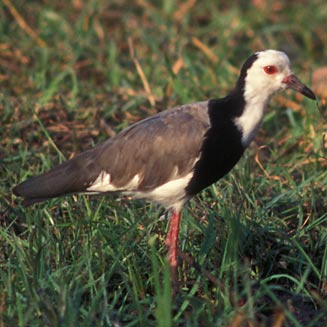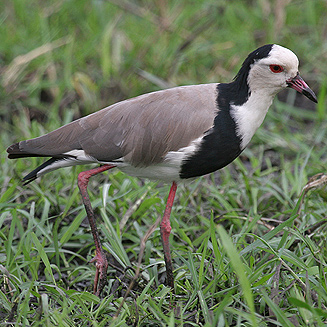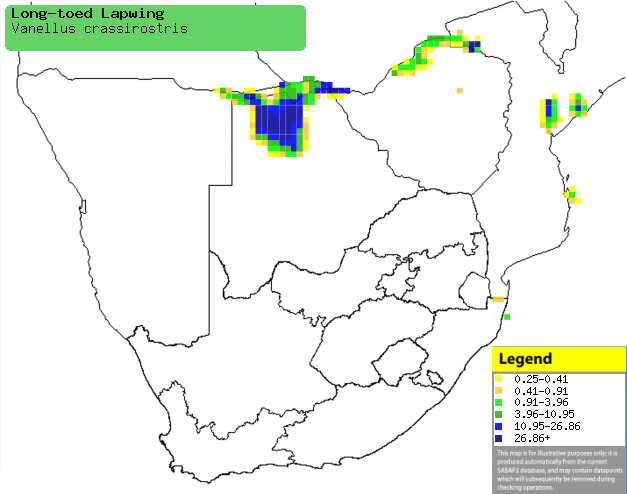|
Vanellus crassirostris (Long-toed
lapwing, Long-toed plover)
Witvlerkkiewiet [Afrikaans]; Langteenkievit [Dutch];
Vanneau à ailes blanches [French]; Langzehenkiebitz [German];
Abibe-de-faces-brancas [Portuguese]
Life
> Eukaryotes >
Opisthokonta
> Metazoa (animals) >
Bilateria >
Deuterostomia > Chordata >
Craniata > Vertebrata (vertebrates) > Gnathostomata (jawed
vertebrates) > Teleostomi (teleost fish) > Osteichthyes (bony fish) > Class:
Sarcopterygii (lobe-finned
fish) > Stegocephalia (terrestrial
vertebrates) > Tetrapoda
(four-legged vertebrates) > Reptiliomorpha > Amniota >
Reptilia (reptiles) >
Romeriida > Diapsida > Archosauromorpha > Archosauria >
Dinosauria
(dinosaurs) > Saurischia > Theropoda (bipedal predatory dinosaurs) >
Coelurosauria > Maniraptora > Aves
(birds) > Order: Charadriiformes
> Family: Charadriidae > Genus: Vanellus
 |
 |
|
Long-toed lapwing. [photo Peter Steyn
©] |
Long-toed lapwing. [photo
Stephen Davis
©] |
Distribution and habitat
Occurs from southern Sudan through eastern DRC, Uganda,
Kenya, Tanzania and Zambia to southern Africa. Within southern Africa it is localised and
generally uncommon in northern Zimbabwe, central Mozambique, the Caprivi Strip
(Namibia) and northern Botswana. It generally prefers emergent and floating
vegetation in swamps, flood plains, ox-bow lakes and dams as well as short
grassland near water, especially with lilies (Nymphaea), Kariba weed (Salvinia
molesta), Bulrush (Typha capensis), ludwigias (Ludwigia),
sedges (Cyperus), Water lettuce (Pistia stratiotes), swamp
cut-grasses (Leersia), wild rice (Oryza), Couch panicum (Panicum
repens), Hippo grass (Vossia cuspidata), duck weed (Wolffia)
and water ferns (Azolla). In the dry season it occasionally moves to
exposed mudflats and gravelly rivers.
|
 |
|
Distribution of Long-toed lapwing in southern Africa,
based on statistical smoothing of the records from first SA Bird Atlas
Project (©
Animal Demography unit, University of
Cape Town; smoothing by Birgit Erni and Francesca Little). Colours range
from dark blue (most common) through to yellow (least common). |
Movements and migrations
Resident and locally nomadic, moving in
response to a changing water level.
Food
It mainly eats aquatic insects, doing most of its foraging
visually, plucking prey from the surface of vegetation or mud. The following food items have been recorded
in its diet:
Breeding
- Hardly studied in southern Africa, it is a monogamous, territorial
solitary nester, defending a small territory against Long-toed lapwings and
other bird species.
- The nest is either a floating platform of vegetation in a swamp or a
shallow scrape in the ground close to water, often surrounded by a moat of
water which dries out after the eggs hatch.
- Egg-laying season starts at or just after peak flooding, lasting from
April-October (mainly July-September).
- It lays 2-4 eggs, which are incubated by both sexes for about 27 days.
After hatching the chicks stay in the nest overnight and are encouraged by
their parents to swim across the nest moat the following day. They remain
close to their parents for many weeks, eventually fledging at about two
months old.
Threats
Not threatened, as it is naturally rare due to its
specialised habitat requirements and has benefited from the spread of alien
weeds, such as Kariba weed (Salvinia molesta).
References
-
Hockey PAR, Dean WRJ and Ryan PG 2005. Roberts
- Birds of southern Africa, VIIth ed. The Trustees of the John Voelcker
Bird Book Fund, Cape Town.
|
